GeoContourPlot[{loc1val1,loc2val2,…}]
makes a geo contour plot from values vali defined at specified locations loci.
GeoContourPlot[locsvals]
uses a collection of locations locs with corresponding values vals.




GeoContourPlot
GeoContourPlot[{loc1val1,loc2val2,…}]
makes a geo contour plot from values vali defined at specified locations loci.
GeoContourPlot[locsvals]
uses a collection of locations locs with corresponding values vals.
Details and Options



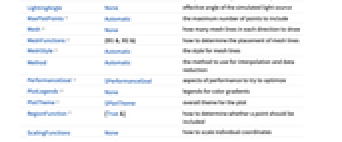
- GeoContourPlot is also known as an isopleth map and thematic map.
- GeoContourPlot displays contour lines on a map where the fields of values interpolated from the geo locations are all the same.
- The geographic locations loci can be given in the following forms:
-
GeoPosition[{lat,lon}] latitude and longitude Entity[…] geographic entity Dated[ent,date] dated entity - Multiple locations locs can be given in the following forms:
-
{reg1,reg2,…} list of individual locations GeoPosition[{pos1,pos2,…}] array of geo positions EntityClass[…] class of geo entities - The values vali can be given in the following forms:
-
vali positive number Quantity[vali,unit] magnitude with units - Multiple values vals can be given in the following forms:
-
{val1,val2,…} list of individual values QuantityArray[{val1,val2,…},unit] array of quantities - In GeoContourPlot[data], data can be given in the following forms:
-
<|loc1val1,loc2val2,…|> association of keys and values GeoPosition[{{lat1,lon1,elev1},…}] geo positions with elevations as the values WeightedData[…] positions with weights for values - GeoContourPlot has the same options as GeoGraphics, with the following additions and changes: [List of all options]
-
BoundaryStyle None how to draw RegionFunction boundaries BoxRatios Automatic effective 3D bounding box ratios ClippingStyle None how to draw values clipped by PlotRange ColorFunction Automatic how to color the plot ColorFunctionScaling True whether to scale the argument to ColorFunction ContourLabels Automatic how to label contour levels Contours Automatic how many or what contours to use ContourShading None how to shade regions between contours ContourStyle Automatic the style for contour lines InterpolationOrder None the polynomial degree in each variable of the interpolated density between data points LightingAngle None effective angle of the simulated light source MaxPlotPoints Automatic the maximum number of points to include Mesh None how many mesh lines in each direction to draw MeshFunctions {#1&,#2&} how to determine the placement of mesh lines MeshStyle Automatic the style for mesh lines Method Automatic the method to use for interpolation and data reduction PerformanceGoal $PerformanceGoal aspects of performance to try to optimize PlotLegends None legends for color gradients PlotTheme $PlotTheme overall theme for the plot RegionFunction (True&) how to determine whether a point should be included ScalingFunctions None how to scale individual coordinates - ColorFunction is supplied with a single argument, given by default by the scaled value of vali.
-
AlignmentPoint Center the default point in the graphic to align with AspectRatio Automatic ratio of height to width Axes False whether to draw axes AxesLabel None axes labels AxesOrigin Automatic where axes should cross AxesStyle {} style specifications for the axes Background None background color for the plot BaselinePosition Automatic how to align with a surrounding text baseline BaseStyle {} base style specifications for the graphic BoundaryStyle None how to draw RegionFunction boundaries BoxRatios Automatic effective 3D bounding box ratios ClippingStyle None how to draw values clipped by PlotRange ColorFunction Automatic how to color the plot ColorFunctionScaling True whether to scale the argument to ColorFunction ContentSelectable Automatic whether to allow contents to be selected ContourLabels Automatic how to label contour levels Contours Automatic how many or what contours to use ContourShading None how to shade regions between contours ContourStyle Automatic the style for contour lines CoordinatesToolOptions Automatic detailed behavior of the coordinates tool Epilog {} primitives rendered after the main plot FormatType TraditionalForm the default format type for text Frame False whether to put a frame around the plot FrameLabel None frame labels FrameStyle {} style specifications for the frame FrameTicks Automatic frame ticks FrameTicksStyle {} style specifications for frame ticks GeoBackground Automatic style specifications for the background GeoCenter Automatic center coordinates to use GeoGridLines None geographic grid lines to draw GeoGridLinesStyle Automatic style specifications for geographic grid lines GeoGridRange All projected coordinate range to include GeoGridRangePadding Automatic how much to pad the projected range GeoModel Automatic model of the Earth (or other body) to use GeoProjection Automatic projection to use GeoRange Automatic geographic area range to include GeoRangePadding Automatic how much to pad the geographic range GeoResolution Automatic average distance between background pixels GeoScaleBar None scale bar to display GeoServer Automatic specification of a tile server GeoZoomLevel Automatic zoom to use for geographic background GridLines None grid lines to draw GridLinesStyle {} style specifications for grid lines ImageMargins 0. the margins to leave around the graphic ImagePadding All what extra padding to allow for labels etc. ImageSize Automatic the absolute size at which to render the graphic InterpolationOrder None the polynomial degree in each variable of the interpolated density between data points LabelStyle {} style specifications for labels LightingAngle None effective angle of the simulated light source MaxPlotPoints Automatic the maximum number of points to include Mesh None how many mesh lines in each direction to draw MeshFunctions {#1&,#2&} how to determine the placement of mesh lines MeshStyle Automatic the style for mesh lines MetaInformation {} meta-information about the map Method Automatic the method to use for interpolation and data reduction PerformanceGoal $PerformanceGoal aspects of performance to try to optimize PlotLabel None an overall label for the plot PlotLegends None legends for color gradients PlotRange All range of values to include PlotRangeClipping False whether to clip at the plot range PlotRangePadding Automatic how much to pad the range of values PlotRegion Automatic the final display region to be filled PlotTheme $PlotTheme overall theme for the plot PreserveImageOptions Automatic whether to preserve image options when displaying new versions of the same graphic Prolog {} primitives rendered before the main plot RasterSize Automatic raster dimensions for the background data RegionFunction (True&) how to determine whether a point should be included RotateLabel True whether to rotate y labels on the frame ScalingFunctions None how to scale individual coordinates Ticks Automatic axes ticks TicksStyle {} style specifications for axes ticks
List of all options
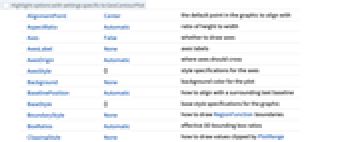
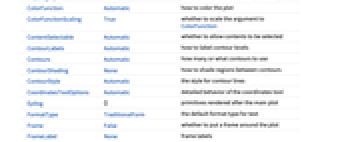
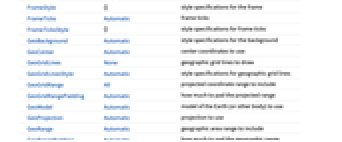
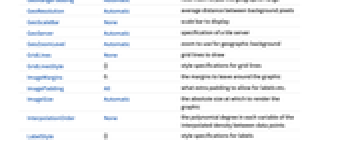
Examples
open all close allBasic Examples (1)
Scope (18)
Data (7)
Plot data associated with geo locations:
Plot gridded values over a specified range of coordinates:
Use an Association with locations for keys and values for counts:
Use WeightedData:
GeoRange is selected automatically based on the data locations:
Use GeoRange to focus on geographic areas of interest:
Specify the number of contours to use:
Use RegionFunction to restrict the density to a region:
Options (78)
AspectRatio (4)
By default, the ratio of the height to width for the plot is determined automatically:
Make the height the same as the width with AspectRatio1:
Use a numerical value to specify the height-to-width ratio:
AspectRatioFull adjusts the height and width to tightly fit inside other constructs:
Axes (4)
By default, Axes are not drawn for GeoContourPlot:
Use AxesTrue to turn on axes:
Use AxesOrigin to specify where the axes intersect:
AxesOrigin (2)
AxesStyle (4)
BoundaryStyle (2)
ColorFunctionScaling (1)
Contours (7)
ContourShading (3)
The automatic shading is None to only show the contour lines:
ContourStyle (4)
The default contour style for data with elevations and a relief map GeoBackground is a black line for values above the sea level and a white line for values below:
The default contour style for data with elevations and a satellite map GeoBackground is a gray line:
Use None to not show contour lines:
Frame (4)
GeoContourPlot does not use a frame by default:
Use FrameTrue to draw a frame around the plot:
FrameLabel (4)
GeoBackground (2)
GeoProjection (1)
Use GeoProjection to change the map projection:
GeoRange (1)
GeoRangePadding (1)
GeoScaleBar (1)
GeoServer (1)
GeoZoomLevel (1)
Explicitly specify GeoZoomLevel to obtain a lower-resolution map rendering:
Explicitly specify GeoZoomLevel to obtain a higher-resolution map rendering:
MaxPlotPoints (2)
Limit the number of points used in each direction:
MaxPlotPoints imposes a regular grid on irregular data:
MeshStyle (2)
PerformanceGoal (2)
PlotLegends (6)
Applications (2)
Properties & Relations (10)
Draw contours through general data with ListContourPlot:
Smoothly shade a map using color with GeoDensityPlot:
Use GeoBubbleChart to show values with scaled bubbles:
Use GeoRegionValuePlot to show values with colored regions:
Use GeoHistogram to aggregate locations into bins:
Use GeoSmoothHistogram to generate smooth densities from locations:
Use GeoListPlot for individual locations:
Use GeoVectorPlot and GeoStreamPlot for vector fields:
Use GeoGraphValuePlot to show the values on geographic networks:
See Also
GeoDensityPlot GeoRegionValuePlot GeoSmoothHistogram GeoVectorPlot GeoStreamPlot GeoGraphPlot ListContourPlot GeoBubbleChart GeoListPlot GeoGraphics
Function Repository: RidgeLineMap
Related Guides
History
Text
Wolfram Research (2020), GeoContourPlot, Wolfram Language function, https://reference.wolfram.com/language/ref/GeoContourPlot.html.
CMS
Wolfram Language. 2020. "GeoContourPlot." Wolfram Language & System Documentation Center. Wolfram Research. https://reference.wolfram.com/language/ref/GeoContourPlot.html.
APA
Wolfram Language. (2020). GeoContourPlot. Wolfram Language & System Documentation Center. Retrieved from https://reference.wolfram.com/language/ref/GeoContourPlot.html
BibTeX
@misc{reference.wolfram_2025_geocontourplot, author="Wolfram Research", title="{GeoContourPlot}", year="2020", howpublished="\url{https://reference.wolfram.com/language/ref/GeoContourPlot.html}", note=[Accessed: 08-December-2025]}
BibLaTeX
@online{reference.wolfram_2025_geocontourplot, organization={Wolfram Research}, title={GeoContourPlot}, year={2020}, url={https://reference.wolfram.com/language/ref/GeoContourPlot.html}, note=[Accessed: 08-December-2025]}